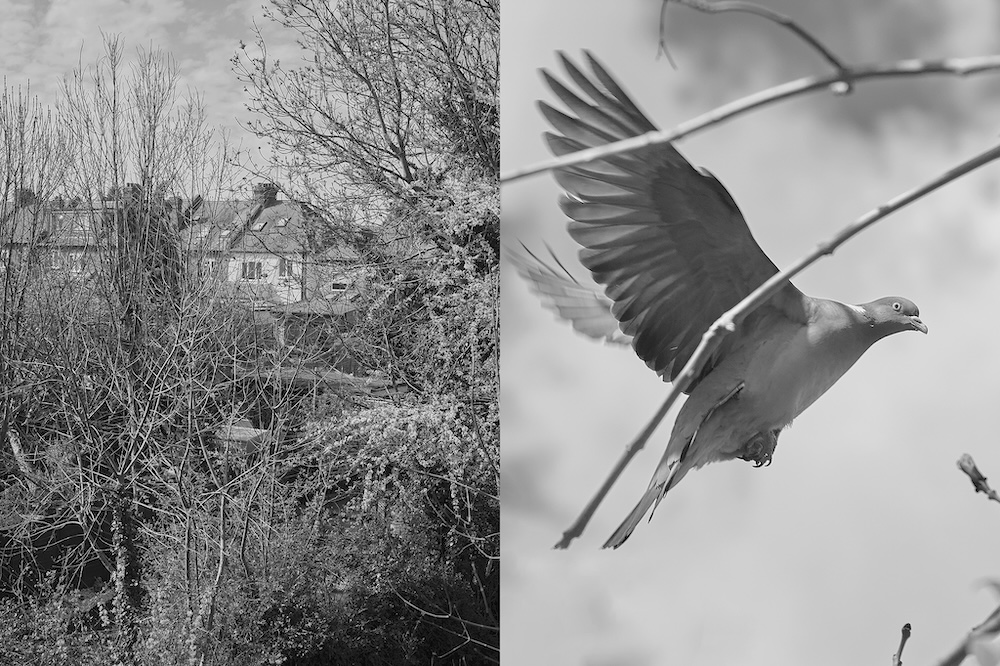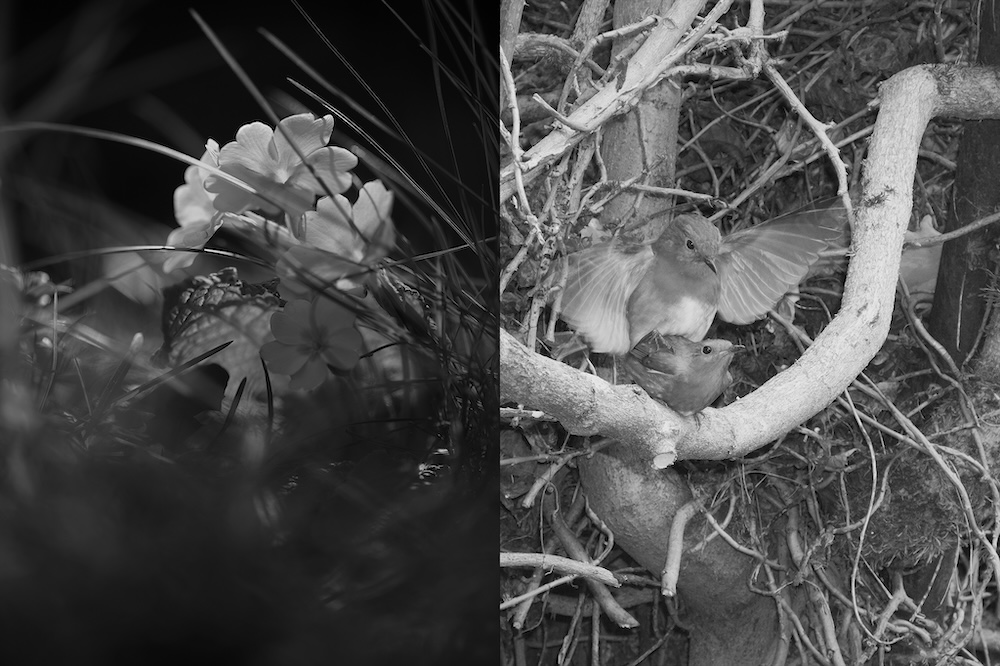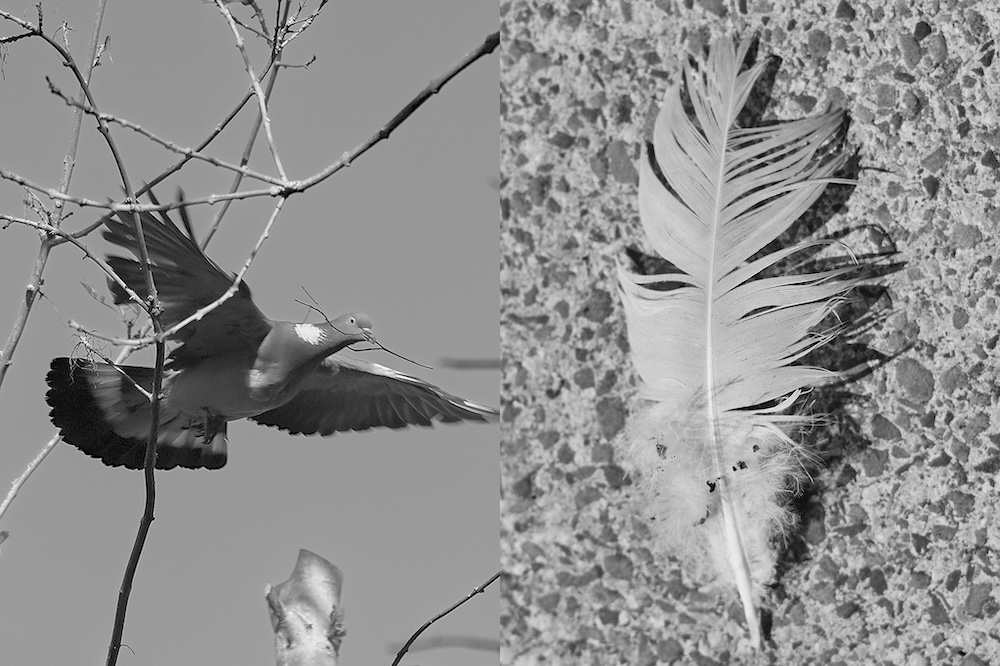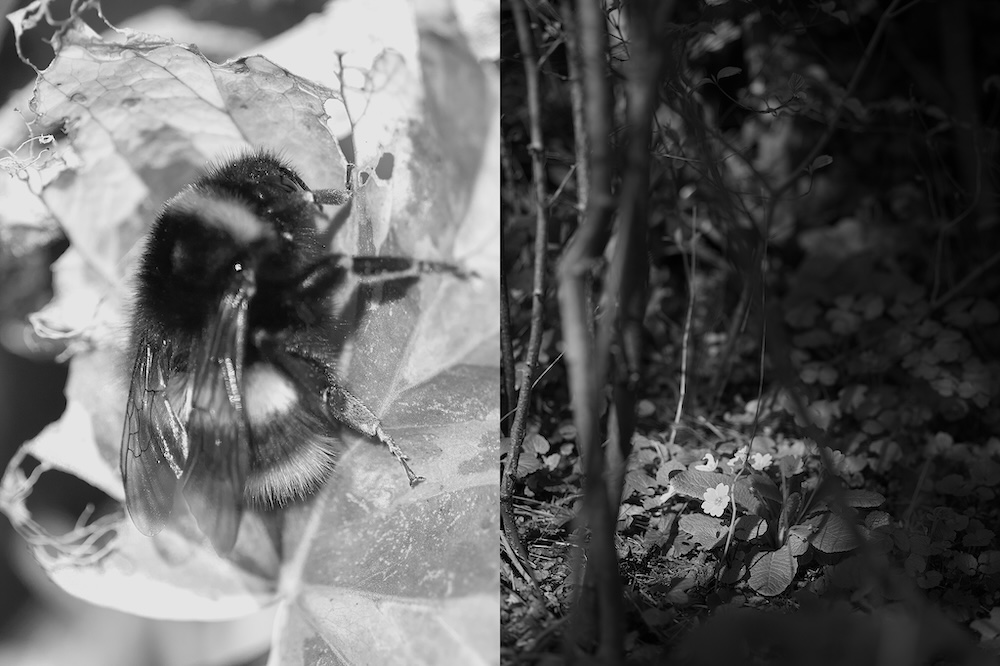The sap is rising in Mark Mattock’s “feral’d” garden in NW2.

March: Love songs from the green uprising
“You can take me to the garden of Eden, leave me there, and see me play” – Neneh Cherry, ‘Synchronised Devotion’.
The loved-up wood pigeons are snogging and necking again, on their love stick; the bare naked black-budded ash branchlet that reaches aimlessly out into the open, twelve feet above the nearest raised bed, just a few feet out from their chosen nest site in the dark green heart of ivy tower. The foreplay has been going on for over twenty minutes now.
It began with a sudden heavy silky whooshing of wings in the peaceful mid-morning lull crescendoing in an audible tap – the moment I looked up — as a wood pigeon dropped onto the branch further along from where its mate had been totally self-engrossed with preening. We momentarily stared at each other. His crazed eye startled wide, as if questioning, in the bright sun. The preener just carried on. After waiting a few moments the cagey male then started hesitantly sidling towards her. Side-stepping his flaky old bleached magenta feet inch by inch along the branch, alternately jerking and pumping his head forward and side to side whilst trying to keep the rest of his body language modest and polite. When within reach he tentatively started nibbling the back of her neck — the one place she couldn’t reach. She turned her head, stretched tall to him, they pressed forcefully into each other. Heads began snaking and sliding like dancing combatant adders, each as if trying to un-violently unbalance the other. They neck passionately, mutually preening, nibbling into each other’s short soft dense feathers. When he pressed against her breast, as if listening to her pumping heart, she nibbled his white and pearlescent eyeshadow-green neck collar. Then he hers. They snog, tongue; shove beaks down each other’s throats, role play as hungry squabs, feeding each other; regurgitating, swallowing, pigeon milk. Crazed, lubriciously dilated pupils stare empty and beyond through semi translucent nictitating membrane, in ecstasy over half-closed true eyelids as heads wobble as if on loose heavy latex necks.
Now the male steps back a couple of steps and lowers, steadies himself on the branch and begins to gently tremble. I suddenly realise, it’s all wrong, he’s not the male, he’s the female. After all the kissing, cuddling, heavy petting, coitus is a quickie; a clumsy wing-flapping balancing act. He jumps off, she ruffles her whole soft silken feathered self back into shape — his gracelessness having messed up her finery — then leaves.
She returns fifteen minutes later, landing this time right next to him, the branch rocks gently under them as she attempts to arouse him again. But he’s too aloof, he leans his head away this time as she tries to love bite and nibble with her beak. Feeling pressured, he flies off. A dance company of glowing ephemeral diptera performs in the slants of warm light between the long shadows, dancing in the low afternoon sun over the swelling greenery, which bulges more obviously where it’s exposed to the rays longest. The sun’s path across the sky, its arch over the garden, can be calculated by the contours of green lushness. This insect plankton having floated up from the emerging umbellifer canopy, writing, choreographing, ‘spring’ over and over in electromagnetic ink that instantly vanishes. It looks erratic but it isn’t, nothing is in nature. Beyond in the spinny, tangled scribblings of bare spiky hawthorn and blackthorn shine out of the deep shade of the far corner. A full spectrum rainbow crocheted into an orb web shimmers in the corner of the old cheap pine-frame swings, softly pulsing iridescence, the only other sign of movement in the lazy stillness.
More signs that the sap is rising. Out front velvet green cushions of leucobryum moss ooze from in between the paving bricks like leaking insulation foam; green larva from a green underworld looking as soft as mouse fur. From above, like some lush alien archipelago of steaming micro-jungle-clad tropical islands and promontories, a lost world. Under the lampposts it looks like wax drippings from the candle above. On the drive rusting alder catkins cover the ground like spilt angler’s bait wriggling to get out of the drying sun, many squashed under foot or glistening with crisped gastropod slime. The tall alder tree is still drenched in them, the heavy laden branches dripping as if the tree has just been hosed.

A clutch of cold iced mornings. They start with the charcoal-black sprays of the ash crowns beginning to faintly glow, each twig warming like the coiled filaments of an old electric heater. From their tips it soaks slowly downwards as if they are dipped in a downside-up elysian pool of radiation, absorbing the reviving solar energy. The tips burst hot orange as the sun pops over the horizon, as the trees climb out of the lingering night. I begin each morning waiting in the pre-dawn, wrapped in padded North Face, hands warmed by the first steaming coffee. From the patio, as the pink-rinse sky blues up and the few bright stars dissolve, a sonic map of territories unfolds, a space that sounds much more vast than it actually is, defined by shrills, trills, caws and chatter, before the urban hum builds and mutes the farthest sounds. The urban avian fauna is more dense in combined gardens than even the healthiest woods. I count seven singing male robins, seven territories; three starlings, a blackbird. Can’t work out if it’s more than one dunnock — their sex life complicated — I think three singing solos or duos; this garden’s, very obvious, with the other two somewhere distant. A song thrush also in the distance, somewhere near the corner shop. The starlings spitting their complex lyrics, sharing their observations, mimicking the avian community around them; one sounds tropical, the nearest very urban. The loudest of this eclectic dawn chorus is by far is the smallest, the diminutive but near nuclear-fuelled wren. I physically jumped one morning when he fervidly exploded onto a loose jasmine vine in full manic display, hollering his tiny lungs out, an exploded feathered ping pong ball like he’d just been hit by an airgun pellet. He dived into the ivy still singing and incredibly continued from inside the nest he’d been building there, the diamond-sharp piercing trill suddenly muted, insulated, by the tightly constructed moss and leaf dome. It’s just ten feet from where I’m sitting. I looked for the female he must be showing the nest to; ‘this one babe, this one.’ I didn’t find her.
A great tit relentlessly rocks his monotonous two chord hit from the highest twig, his most familiar from a considerable repertoire of two and three chord songs. Just beneath him blue tits and long tailed tits are picking the sour yellow and colourless grey scabs of lichens that crust the highest branches, now in the primrose-yellow phase of increasing brightness, against a starling-egg-blue sky. The long tailed tits maybe gathering nest material. The blue tits food. From somewhere unseen calling herring gulls conjure false impressions. The soundscape hits max volume, the air full of tunes: swaggering, lusty, cocksure, insolent, sassy, brazen, impudent, over which the carrion crow caws zealously from his TV aerial pulpit, bowing repeatedly as if in some religious fervour, fanning his black priestly robes which shine from wear.
By full light of mid-morning the ash boles and boughs flare like bleached bones. Below in the thorn spinny, a blast of blackthorn blossom, snow bush, more than last year, but it’s still more flurry than snow storm. In the snarl of ‘sparrow bush’ the yellow forsythia blossom has transformed it into something seen in the giant middens of farm scrap; it looks like coils of barbed wire that got dragged across the daffodils. Deep inside, the sparrows, now obsessed with fluffy white feathers, chat. They are building in the old starlings’ nest hole under the guttering. The starlings yet to evict them. A male dunnock — hedge sparrow ‚ is singing in his piercing scatter trill from the very heart of the tangle, I can see his throat trembling, the only visible movement. As a hunting sparrowhawk it’s all I’d need to see at the last crucial second, as I homed in on the song, at silent speed, tight to the hedge.
Late mornings now, sounds of multiple wings, from the thrum of wrens to the whistling helicopter whoosh of the woodies. Relentless to-ing and fro-ing. The trodden ground immediately after the patio slabs is now the hub of a builders’ supply yard with plumed builders picking up their materials. The female robin dropping down every thirty seconds, bouncing about with serious purpose, looking for large, limp, well-rotted leaves. Finding one, barely able to fly it back, bird and vegetation like a large brown drunk moth crashing into the light. She’s so light she repeatedly struggles to haul the unmanageable material into the dark interior of the lower part of ivy tower. Over the hours the progression of the build can be followed by the succession of materials she chooses, getting finer and finer: smaller leaf bits, grass stems, pet hair, for the deep cup. I know it’s complete when I catch an illicit act of consummation. This will be a successful nest, it is supremely well hidden. One of those nests that can only be ‘seen’ with the tips of once curious youthful fingers.

Sparrows pull at dry grass, loosing much in sparrow bush, where they stop off before taking it to the roof. The male wood pigeon (pretty sure) crash lands every minute or so, smashing through the shining wall of ivy solar panels with another fine stick he prefers to collect from the back for his mate, now brooding. The sheer amount of sticks he brings suggests a substantial construction, but wood pigeon nests are no more than flimsy platforms. It says more about his bumbling ineptitude, which is witnessed on every return: he’s constantly replacing what he displaces, especially when he gets completely stuck, struggles with a stick way too long. Every corvid, and our cat, for sure, knows where this nest is, and it’s visible from below on the patio, and above from the bedroom window. It just depends how fat they want their squabs. Patience.
Tits, great and blue, sparrows, and occasionally the robin, yank at the wool insulation mats that came with meat deliveries, now used as winter covering on the nearest of the two raised beds. Miniature scavengers on a giant rotting carcass. It never occurred to me at the time how important this would be. The wool is organic, clean, free of the hyper-toxic insecticides fipronil and imidacloprid, banned by the EU for agricultural use but common in veterinary cat and dog flea treatments. My immediate neighbours either side are self-proclaimed animal lovers with up to twelve dogs between them (the noise and smell an ongoing issue), the hair from which the nest-builders, particularly the hole nesters, collect and use for lining1. The blue tits pull and stretch until they almost tip backwards with the sheer effort. A magpie with an arrogant swagger, shimmering in iridescent oil slick plumes, searches for rootlets on green seedling-dusted ground. Loses all elegance when it finds what it wants and tries to yank it free.
More sun. Bees; bombuses? Bombi? Bombing about. Queens: Big buff-tailed bombus terrestris, early bombus pratorum, garden bombus hortorum, whose longest of tongues I watch delving into the plastically coloured mauve and pink florets of the lungwort hiding in the garlic and dog’s mercury. Its leaves of white spots as if it has some lurgy or is advertising some medieval cure for lung diseases. White-tailed bombus lucorum, red arsed bombus lapidarius, common carder bombus pascuorum. Queens, nest hunting, refuelling in the split splashes of primroses slowly now sinking under the green upswell.

Picking the first garlic leaves, a sudden a noisy din overhead, the sound of parakeets, but unfamiliar, like panicked freaked-out parrots. It is, directly above in the pale-hazed blue, a soaring female sparrowhawk with half a dozen parakeets swirling tightly all around her, almost as if attached by invisible threads. The harassment is frantic, the hawk totally chilled.
‘I fucking hate ivy,’ Ben the tree surgeon’s constant mantra as he clambers in the canopy trying to rope up. He’s done ivy tower; it’s now truly an ivy tower, a giant totemic green-clad column, gone the branches that exploded from its top that would make the bedroom view feel claustrophobic when all was in full summer leaf. He’s now sorting the largest ash that fills the far left corner of the space. He and his boss Dan, sympathetic, they get it, understand that I’m thinning the canopy so more light reaches the ground. That I want to keep all the wood, they don’t need to take away and mulch, that I will inoculate the larger logs with turkey tail spawn. Have plenty of fire pit fuel. That dead wood is half of a whole healthy wood, its nutrient bank. It’s the last interference that I really needed to make. It looks like they trashed the place. It looks like the aftermath of a terrible storm, a disaster. But if you know, it isn’t, in my eyes: through the multi-senses of all the fauna and flora, it’s as should be. Ben and Dan are both underpaid firefighters who earn more doing this. That’s not the right way round, is it?
None of the residents of ivy tower abandoned it. No nests were harmed. The brooding hen wood pigeon fills the air with a mesmeric purr as she sits on her eggs inside the tower. It’s intoxicating, hypnotic. A sonorous two-note groan or growl, but so soothing. lt’s like sitting close to a massive speaker. This incredible sound reverberating through me; through wood, leaf, air, yolk, flesh; through every cell. The male leaves having dropped off yet another stick, I feel the down draft of his wings ashe passes over my shaven head as I sit staring out at everything.
The neighbour strikes up his barbecue, the smell of that moment you step onto a plane, of airport runway, wafts across the patio. On shit days the garden feels like some last stand, but it’s not is it? It’s resistance. This garden is an act of resistance, and sanctuary.
***
1 Research recently released from the University of Sussex, funded by bird charity SongBirdSurvival, has found high levels of harmful chemicals from pet flea treatment in bird’s nests lined with animal fur, is leading to an increased mortality rate of chicks. The new study shows that the fur birds use to build the inner lining of their nests contained chemicals used in pet flea treatments, such as fipronil. The researchers collected 103 nests from blue and great tits which were lined with fur. They detected 17 out of the 20 insecticides screened. 100% of nests contained fipronil, which was banned in the EU for agricultural use in 2013, and 89% contained imidacloprid, which was banned in the EU as a plant protection product in 2018.
*
Mark Mattock. Artist. Photographer. Publisher. Rabbit Fighter. @the_rabbit_fighters_club